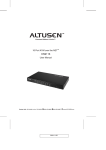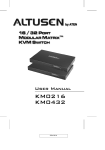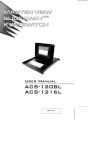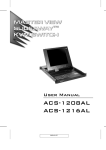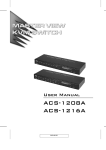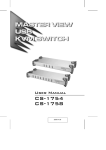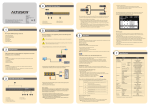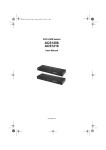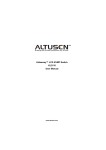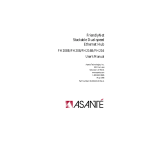Download Altusen KL0116 Instruction manual
Transcript
FCC Information This is an FCC Class A product. In a domestic environment this product may cause radio interference in which case the user may be required to take adequate measures. This equipment has been tested and found to comply with the limits for a Class A digital device, pursuant to Part 15 of the FCC Rules. These limits are designed to provide reasonable protection against harmful interference when the equipment is operated in a commercial environment. This equipment generates, uses and can radiate radio frequency energy and, if not installed and used in accordance with the instruction manual, may cause harmful interference to radio communications. Operation of this equipment in a residential area is likely to cause harmful interference in which case the user will be required to correct the interference at his own expense. © Copyright 2003 ALTUSEN® PAPE-0215-2AX All brand names and trademarks are the registered property of their respective owners. 2003-07-23 Package Contents The complete KL0116 16-Port LCD Console KVM Switch package contains the following components: M 1 KL0116 KVM Switch M 2 Custom KVM Cable Sets M 1 Firmware Upgrade Cable M 1 Power Cord M 1 Rack Mounting Kit (Optional) M 1 User Manual M 1 Quick Start Guide M 1 Warranty / Registration Card Check to make sure that all the components are present and in good order. If anything is missing, or was damaged in shipping, contact your dealer. Read this manual thoroughly and follow the installation and operation procedures carefully to prevent damage to the switch or any of the devices that connect to it. ii 2003-07-23 Contents About this Manual Overview . . . . . . . . . . . . . . . . . . . . . . . . . . . . . . . vi Conventions . . . . . . . . . . . . . . . . . . . . . . . . . . . . . vii Getting Help ALTUSEN Technical Support . . . . . . . . . . . . . . . . . . . viii ALTUSEN Authorized Resellers . . . . . . . . . . . . . . . . . . viii Chapter 1 Introduction Overview . . . . . . . . Features . . . . . . . . . Benefits . . . . . . . . . Hardware Requirements Computers . . . . . Cables . . . . . . . . KL0116 Front View . . . KL0116 Rear View . . . . . . . . . . . . . . . . . . . . . . . . . . . . . . . . . . . . . . . . . . . . . . . . . . . . . . . . . . . . . . . . . . . . . . . . . . . . . . . . . . . . . . . . . . . . . . . . . . . . . . . . . . . . . . . . . . . . . . . . . . . . . . . . . . . . . . . . . . . . . . . . . . . . . . . . . . . . . . . . . . . . . . . . . . . . . . . . . . . . . . . . . . . 1 3 4 4 4 5 6 9 Single Stage Installation . . . . Daisy Chaining . . . . . . . . . Hot Plugging . . . . . . . . . . Switching Station Positions: Hot Plugging CPU Ports: . . Powering Off and Restarting . . Port ID Numbering . . . . . . . Port Selection . . . . . . . . . . . . . . . . . . . . . . . . . . . . . . . . . . . . . . . . . . . . . . . . . . . . . . . . . . . . . . . . . . . . . . . . . . . . . . . . . . . . . . . . . . . . . . . . . . . . . . . . . . . . . . . . . . . . . . . . . . . . . . . . . . . . . . . . . . . . . . . . . . . . . . . . . . . 11 . 12 . 14 . 14 . 14 . 14 . 15 . 15 Chapter 2 Installation iii 2003-07-23 Chapter 3 Hotkey Operation Hotkey Port Access . . . . Invoking Hotkey Mode Selecting the Active Port Auto Scanning . . . . . Skip Mode . . . . . . . Hotkey Beeper Control . . . Hotkey Summary Table . . . . . . . . . . . . . . . . . . . . . . . . . . . . . . . . . . . . . . . . . . . . . . . . . . . . . . . . . . . . . . . . . . . . . . . . . . . . . . . . . . . . . . . . . . . . . . . . . . . . . . . . . . . . . . . . . . . . . . . . . . . . . . . . . . . . . . . . . . . . . . . . . . . . . 17 17 18 19 21 21 22 OSD Overview . . . . . . . . . OSD Navigation . . . . . . . . OSD Main Screen Headings OSD Functions . . . . . . . . . F1 GOTO: . . . . . . . . . F2 LIST: . . . . . . . . . . F3 SET: . . . . . . . . . . . F4 ADM: . . . . . . . . . . F5 SKP: . . . . . . . . . . . F6 BRC: . . . . . . . . . . F7 SCAN: . . . . . . . . . F8 LOUT: . . . . . . . . . . . . . . . . . . . . . . . . . . . . . . . . . . . . . . . . . . . . . . . . . . . . . . . . . . . . . . . . . . . . . . . . . . . . . . . . . . . . . . . . . . . . . . . . . . . . . . . . . . . . . . . . . . . . . . . . . . . . . . . . . . . . . . . . . . . . . . . . . . . . . . . . . . . . . . . . . . . . . . . . . . . . . . . . . . . . . . . . . . . . . . . . . . . . . . . . . . . . . . . . . . . . . . . . . . . . . . . . . . 23 . 24 . 25 . 25 . 26 . 27 . 28 . 31 . 34 . 35 . 36 . 37 . . . . . . . . . . . . . . . . . . . . . . . . . . . . . . . . . . . . . . . . . . . . . . . . . . . . . . . . . . . . . . . . . . . . . . . . . . . . . . . . . . . . . Chapter 4 OSD Operation Chapter 5 The Firmware Upgrade Utility Before You Begin . . . . . . Starting the Upgrade . . . . Upgrade Succeeded . . . . . Upgrade Failed . . . . . . . Firmware Upgrade Recovery . . . . . . . . . . . . . . . . . . . . iv 2003-07-23 39 40 42 42 43 Chapter 6 Remote Console Operation Installation . . . . . . . . . . . . . . . . . . . . . . . . . . . . . . 45 Operation . . . . . . . . . . . . . . . . . . . . . . . . . . . . . . . 46 Appendix KL0116 Connection Table . . . . . . . OSD Factory Default Settings . . . . . . . Specifications . . . . . . . . . . . . . . . . LCD Operation Reference . . . . . . . . . Clear Login Information . . . . . . . . . . Module Removal . . . . . . . . . . . . . . Removing the KVM Module . . . . . . Removing the Keyboard and Touchpad Rack Mounting . . . . . . . . . . . . . . . Standard Rack Mounting . . . . . . . . Optional Rack Mounting . . . . . . . . Limited Warranty . . . . . . . . . . . . . . . . . . . . . . . . . . . . . . . . . . . . . . . . . . . . . . . . . . . . . . . . . . . . . . . . . . . . . . . . . . . . . . . . . . . . . . . . . . . . . . . . . . . . . . . . . . . . . . . . . . . . . . . . . . . . . . . . . . . . . . . . . . . . . . . . . . . . . . . . . . . . . . . 47 . 48 . 49 . 50 . 51 . 52 . 52 . 53 . 54 . 54 . 54 . 56 v 2003-07-23 About This Manual This User Manual provides information concerning the installation, configuration, and operation of the KL0116 16-Port LCD Console KVM Switch. Overview Chapter 1, Introduction, introduces you to the KL0116. Its purpose, features and benefits are presented, and its front and back panel components are described. Chapter 2, Installation explains how to set up your installation — from a basic single stage hookup to a complete three stage operation. Chapter 3, Hotkey Operation, details the procedures used in the Hotkey operation of your KL0116 installation. Chapter 4, OSD Operation, provides a complete description of the KL0116’s OSD (On Screen Display), and explains the procedures usded to manipulate it. Chapter 5, The Firmware Upgrade Utility, describes how to upgrade the KL0116’s firmware with the latest available version. Chapter 6, Remote Console Operation, explains how to operate the KL0116 from a remote console (up to 150 meters / 500 feet away). An Appendix provides technical and other important information regarding the KL0116. vi 2003-07-23 Conventions This manual uses the following conventions: Courier Indicates text that you should key in. [] Indicates keys you should press. For example, [Enter] means to press the Enter key. If keys need to be chorded, they appear together in the same bracket with a plus sign between them: [Ctrl+Alt]. 1. Numbered lists represent procedures with sequential steps. M Bullet lists provide information > Indicates selecting an option on a menu. For example, Start > Run means to open the Start menu, and then select Run. Indicates critical information. Getting Help For additional help, advice, and information, ALTUSEN provides several support options. If you need to contact ALTUSEN technical support with a problem, please have the following information ready beforehand: M Product model number, serial number, and date of purchase. M Your computer configuration, including operating system, revision level, expansion cards, and software. M Any error messages displayed at the time the error occurred. M The sequence of operations that led up to the error. M Any other information you feel may be of help. vii 2003-07-23 ALTUSEN Technical Support North America Technical Phone Support Registered ALTUSEN product owners are entitled to telephone technical support. Call the ALTUSEN Technical Support Center: 949-453-8885. International Technical Phone Support 1. Contact your local dealer. 2. Call the ALTUSEN Technical Support Center: 1-949-453-8885. Email Support Email your questions and concerns to: [email protected] Online Troubleshooting The ALTUSEN support website: http://www.altusen.com/support provides online troubeshooting that describes the most commonly encountered problems and offers possible solutions to them. Online Documentation User Manuals are available electronically at the ALTUSEN support website: http://www.altusen.com/support Software Updates Download the latest drivers and firmware for your product from the ALTUSEN support website: http://www.altusen.com/support Product Information For information about all of ALTUSEN’s products and how they can help you connect without limits, visit ALTUSEN on the webat http://www.altusen.com ALTUSEN Authorized Resellers ALTUSEN provides the following ways to find an authorized reseller in your area: M In the United States of America, call: 866-ALTUSEN M In Canada and South America, call: 949-453-8885 M In all other locations, call: 886-2-8692-6959 M Visit ALTUSEN on the web at http://www.altusen.com for a list of locations and telephone numbers viii 2003-07-23 Chapter 1. Introduction Overview The ALTUSEN 16-Port LCD Console KVM Switch offers a highly efficient network management solution. Custom designed high-density CPU connectors allow a 16-port KVM switch to fit into a 1U high rack space. Additional ALTUSEN switches can be daisy chained to the KL0116, allowing up to 512 computers to be controlled from its LCD console. The KL0116 offers many advanced features, such as intuitive On Screen Display (OSD), Hotkeys, excellent video resolution, two level User password security with different security clearances, and flash ROM for firmware upgrades. The ALTUSEN KL0116 offers a space-saving, streamlined approach to KVM switch technology, integrating a keyboard, LCD monitor, and touchpad in a 1U high slide-out housing. The LCD display is built into the cover, and the keyboard and trackball are built into the base. Simply slide the KVM module section out; flip the cover up; and you are ready to go to work. The KL0116’s modular design also allows you to detach the KVM module from the switch module for maintenance. For further convenience, the switch can be operated from an independent, external KVM console with the addition of an ALTUSEN Console Extender (not included). The KL0116 also features high density 15 pin connectors instead of the usual 25 pin connectors. This space-saving innovation allows installation of a full, 16 port switch in a 1U system rack. An included Firmware Upgrade Utility protects your KL0116 investment. You can stay current with the latest functionality imporvements by downloading firmware update files from the ALTUSEN website as they become available, and use the utility to quickly and conveniently perfrom upgrades. Setting up the KL0116 is fast and easy, consisting of plugging cables into their appropriate ports. Because the KL0116 intercepts keyboard input directly, there is no software to configure, and therefore no complex installation routines or incompatibility problems. 1 2003-07-25 You can easily access to any computer on the installation either by entering Hotkey combinations from the keyboard, or by using the powerful menu driven OSD system. A convenient Auto Scan feature also permits automatic scanning and one-by-one monitoring of the activities of selected computers. 2 2003-07-25 Features The main features of the KL0116 are as follows: w A single slide-out console integrated with the KVM switch controls up to 16 computers directly w Slide-out console features a 15" LCD monitor that can tilt back to a 30 viewing angle. o w Modular design - the keyboard and touchpad module, as well as the KVM Switch module, are easily removed for convenient maintenance w Dedicated chain ports to link up to 31 additional High Density KVM Switches (model KH0116) to control up to 512 computers from the slide-out console w Plug-n-Play; no software required w Convenient computer selection via intuitive On Screen Display (OSD) menus, Hotkeys, or pushbutton switches w Remote console port for optional control of servers from up to 500 feet away w Auto Scan feature for monitoring selected computers w Hot pluggable - add or remove computers without having to power down the switch w Auto-sensing of station position on daisy chained installations - no need for manual DIP switch setting w Port names automatically reconfigured when station sequence is changed w Two level password security - up to four authorized Users and an Administrator view and control the computers, with separate profiles for each w Two level logout - manual and timed w PS/2 keyboard and mouse emulation allows computers to boot the even when they are not selected w 15" RGB analog LCD display supporting high XGA resolutions of up to 1024 x 768 with 250 cd/m2 brightness w Firmware upgradable via flash ROM w Full range universal internal power supply (AC 100-240 V) w Console Lock - keeps the sliding console securely locked away when not in use 3 2003-07-25 Benefits The KL0116 saves time and money by allowing a single console to manage all of your computers. Specifically, the benefits of a KL0116 installation are these: w Eliminates the expense of purchasing a keyboard, monitor, and mouse for each computer w Eliminates the space needed for the extra KVM components w More efficient use of space than standard KVM switches w Saves on energy costs w Eliminates the inconvenience and effort required to physically move from one computer to another Hardware Requirements Computers The following equipment must be installed on each computer: w A VGA, SVGA or Multisync card. Note: Since the integrated LCD monitor’s maximum resolution is 1024 x 768, the video resolution settings for each computer must not exceed 1024 x 768. w A 6-pin mini-DIN (PS/2 style) mouse port.* w Either a 6-pin mini-DIN (PS/2 Style) keyboard port with +5V DC on pin 4 and Ground on pin 3, or a 5-pin DIN (AT Style) keyboard port with +5V DC on pin 5 and ground on pin 4.* * 1. See the note under Cables on p. 5. 2. For Mac, Sun, and Linux computers, PS/2 to USB converters are required. If you plan to use these on your KL0116 installation, see your dealer for details 4 2003-07-25 Cables Substandard cables may damage the connected devices or degrade overall performance. For optimum signal integrity and to simplify the layout, we strongly recommend that you use the high quality CS Custom Cable sets described below: Function CS Part Number KVM Switch to KVM Switch (Daisy Chaining) KL1700 - 0.6 m KL1701 - 1.8 m KVM Switch to Computer KL5201P - 1.2 m KL5202P - 1.8 m KL5203P - 3.0 m KC1700 / KC1701 KC5201P / KC5202P / KC5203P Note: 1. The KL0116 does not support serial mice. You cannot use Serial-to-PS/2 adapters with the cables. 2. If your computer uses an AT style keyboard socket you will need to purchase a PS/2-to-AT keyboard adapter in order to plug the cable into the computer’s keyboard port. 5 2003-07-25 KL0116 Front View 1 2 3 4 5 10 9 6 7 8 1. Handle Pull the handle to slide the KVM module out; push to slide the module in. 2. LCD Screen 3. Port Selection Switches / Port LEDs Press a switch to bring the KVM focus to its corresponding port. Note: 1. You must be logged in to use these switches. Otherwise, pressing them will have no effect. 2. The focus will only switch to ports that you have access rights to (see SET ACCESSIBLE PORTS, p. 1-33). If you don’t have access rights to a port, pressing the switch will have no effect. w Pressing Buttons 1 and 2 for three seconds performs a keyboard and mouse reset. w Pressing Buttons 15 and 16 for three seconds initiates Auto Scan Mode (see p. 20, and F7 SCAN, p. 36). 6 2003-07-25 Two LEDs are built into each selection switch. The one on the left is the On Line LED; the one on the right is the Selected Port LED: w An On Line LED lights GREEN to indicate that the device attached to its corresponding port is up and running. w A Selected LED lights AMBER to indicate that its corresponding port is the one that has the KVM focus. The LED is steady under normal conditions, but flashes when its port is accessed under Auto Scan Mode (see F7 SCAN, p. 36). w Each time the KL0116 is powered on, the On Line and Selected LEDs blink in sequence as the Switch performs a self-test. 4. Keyboard Note: The special functions for the F6, F9, F10, F11, and F12 function keys as well as the Esc and Z keys (the functions that are enabled when the Fn key is held down), are not supported at this time. 5. Touchpad 6. Power LED Lights BLUE to indicate that the unit is receiving power. 7. Console Release The KL0116 has a mechanism that locks it in the “In” position to prevent it from accidentally sliding out. To slide the console out, push this tab sideways. 8. Rack Mounting Brackets There are rack mounting brackets attached to each corner of the unit. They are used to secure the chassis to a system rack. 7 2003-07-25 9. Reset Switch Pressing this switch in performs a system reset. This switch is recessed and must be pushed with a thin object - such as the end of a paper clip, or a ballpoint pen. 10. LCD Display Controls w Buttons to control the position and picture settings of the LCD display are located here, as well as a buton to Enable/Disable operating the KL0116 from an optional remote console. See the Remote Console Operation chapter (p. 45) and the LCD Operation section (p. 50) for details. w The Local and Remote LEDs light to indicate that their respective consoles are active. 8 2003-07-25 KL0116 Rear View 1 2 4 3 5 6 7 1. Power Switch This is a standard rocker switch that powers the unit On and Off. 2. Power Socket The AC power cord plugs in here. 3. Daisy Chain Port When Daisy Chaining Units, the Daisy Chain cable plugs in here. 4. CPU Port Section The KVM cables that link to the computers plug in here. Because of the connector shape, only cables designed to work with this switch (see p. 5) can plug in. Do NOT attempt to use ordinary 15 pin VGA connector cables to link these ports to the computers. Note: See the Cables section, p 5, for detailed information about cables. 9 2003-07-25 5. Remote Console Port The KL0116 can be operated from a remote console up to 500 feet (150 meters) away with the optional purchase of a KA9250 Console Extender Module. If the Extender Module is used, its cable plugs into this RJ-45 connector. See the Remote Console Operation chapter (p. 45) and the LCD Operation section (p. 50) for details about remote console operation. 6. Firmware Upgrade Port The KL0116’s firmware can be upgraded. To perform an upgrade, the Firmware Upgrade Cable plugs into this RJ-11 connector (see p. 39 for details). 7. Firmware Upgrade Recovery Switch This switch should be in the NORMAL position during normal operation and while performing a fimware upgrade. See p. 43 for further details about the use of this switch. 10 2003-07-25 Chapter 2. Installation Single Stage Installation In a Single Stage installation, there are no additional switches daisy chained down from the first unit. To set up a single stage installation do the following: 1. Use KVM cable sets (as described in the Cables section on p. 5), to connect any available CPU Port to the Keyboard, Video and Mouse ports of the computer you are installing. Note: Disregard the Daisy Chain Port at this time. It is only used for daisy chaining a KH0116 switch to the KL0116. Daisy chaining is described in the next section of this chapter. 2. Plug the female end of the power cable into the KL0116’s Power Socket, then plug the male end into an AC power source. 3. Turn on the power to the KL0116. 4. Turn on the power to the computers. 11 2003-07-25 Daisy Chaining To control even more computers, up to 31 additional ALTUSEN KVM switches can be daisy chained down from the KL0116. Note: KH0116 switches are used for daisy chaining, since there is no need for consoles on the chained switches. The KH0116 is similar to the KL0116, except that it comes in a standard housing without the slide-out console. Tables showing the relation between the number of computers and the number of switches needed to control them are provided on p. 47. To set up a daisy chained installation, do the following: 1. Turn off the power to all the devices you will be connecting to the installation. 2. Use a daisy chain cable set (described in the Cables section, p. 5), to connect the KL0116’s Daisy Chain Portto the first KH0116’s Chain In port. Note: 1. The KL0116 is referred to as the First Station; the first KH0116 in the chain is the Second Station, etc. 2. In a daisy chained installation, a switch is the child of the switch above it, and the parent of the switch below. 12 2003-07-25 3. For additional KH0116 switches, use daisy chain cable sets to connect the Chain Out port of the parent KH0116 to the Chain In port of the child (Second Station Out to Third Station In, Third Station Out to Fourth Station In, etc.). 4. Use KVM cable sets (described in the Cables section, p. 5), to connect any available CPU Port to the Keyboard, Video and Mouse ports of the computers you are installing. 5. Power up the installation as follows: a. Power on the First Station. b. Power on each Station in turn (Second Station, then Third Station, etc.). In each case, wait for the Station ID to be displayed on the Station ID LED before powering on the next station. (The Station ID for the Second Stage unit is 02, the ID for the Third Stage unit is 03, etc.) c. After all the Stations are up, power on the computers. 13 2003-07-25 Hot Plugging The KL0116 supports hot plugging. You can remove or add components on the installation by unplugging their cables from the ports without shutting the unit down. In order for hot plugging to work properly, you must follow these procedures: Switching Station Positions: You can switch KVM station positions by simply unplugging from the old parent and plugging into a new one. After you do, in order for the OSD menus to correspond to the change, you must reset the Station IDs in the OSD. See RESET STATION IDS, p. 34, for details. Hot Plugging CPU Ports: In order for the OSD menus to correspond to the change, you must manually reconfigure the OSD to reflect the new Port information. See the F3 SET (p. 28) and F4 ADM (p. 31), functions for details. Note: This function may not work properly if the computer’s operating system does not support hot plugging. Powering Off and Restarting If it becomes necessary to Power Off the KL0116 or one of the daisy chained units. Before starting it back up you must do the following: 1. Shut down all the computers that are attached to it. Note: Unplug the power cords of any computers that have the Keyboard Power On function. Otherwise, the switch will still receive power from the computers. 2. Wait 10 seconds, then power the switch back on. 3. After the switch is up, power on the computers. Note: If you have shut down more than one Station (KVM switch), power up the highest Station first and work your way down to the lowest one. 14 2003-07-25 Port ID Numbering Each CPU port on the KVM installation is assigned a unique Port ID. The Port ID is made up of two parts: a Station Number, and a Port Number: M The Station Number is a two digit number that reflects the switch’s position in the daisy chain sequence. M The Port Number - is a two digit number which reflects the port on the Station that the computer is connected to. M The Station Number precedes the Port Number. M Station and Port numbers from 1 - 9 are padded with a preceding zero and appear as 01 - 09. For example, a computer attached to Port 6 of Station 12 would have a Port ID of: 12-06. Port Selection There are three port selection methods: Manual; entering Hotkey combinations from the keyboard; and with the menu-driven On Screen Display (OSD). With manual port selection you simply press the appropriate Port Selection Switch located above the keyboard (see p. 6 for details). Hotkey port selection is discussed in the next chapter; OSD operation is described in Chapter 4. 15 2003-07-25 Notes: 16 2003-07-25 Chapter 3. Hotkey Operation Hotkey Port Access Hotkey Port Access allows you to provide KVM focus to a particular computer directly from the keyboard. The KL0116 provides the following Hotkey Port Access features: w Selecting the Active Port w Auto Scanning w Skip Mode Switching Invoking Hotkey Mode All Hotkey operations begin by invoking Hotkey Mode. Invoking Hotkey Mode takes three steps: 1. Hold down the Num Lock key; 2. Press and release the minus key; 3. Release the Num Lock key: [Num Lock] + [-]; Note: Press and release the minus key within one half second, or else Hotkey invocation is cancelled. 17 2003-07-25 When Hotkey Mode is active: w The Caps Lock, and Scroll Lock LEDs flash in succession. They stop flashing after you exit Hotkey Mode. w A command line displays on the monitor screen. The command line prompt is the word Hotkey: in yellow text on a blue background. Text that you key in displays on the command line after the prompt. w Ordinary keyboard and mouse functions are suspended. You can only input Hotkey compliant keystrokes and mouse clicks (as described in the sections that follow). w To exit Hotkey mode, you must press [Esc]. Selecting the Active Port Each CPU port is assigned a unique Port ID (see p. 15). You can directly access any computer on the installation with a Hotkey combination that specifies the Port ID of the CPU Port that the computer you want to access is connected to. To select the active port, do the following: 1. Invoke Hotkey Mode (see p. 17). 2. Key in the Port ID The Port ID numbers display on the command line as you key them in. For example, your would key in 0305 to give the KVM focus to the computer attached to Port 5 of KVM Station 3. If you make a mistake, use [Backspace] to erase the wrong number. 3. Press [Enter] After you press [Enter], the KVM focus switches to the designated computer and you automatically exit Hotkey Mode. 18 2003-07-25 Auto Scanning Auto Scan automatically switches among all the active CPU Ports that are accessible to the currently logged on User at regular intervals, allowing him to monitor their activity automatically. (See Scan/Skip Mode of the OSD F3 SET function, p. 30 for information regarding accessible ports.) Setting the Scan Interval: The amount of time Auto Scan dwells on each port is set with the Scan Duration setting of the OSD F3 SET function (see p. 29). If you like, you can change the scan interval time before you activate Hotkey Auto Scanning. To change the scan interval, use the following Hotkey combination: 1. Invoke Hotkey Mode (see p. 17). 2. Key in [T] [n] Where [T] is the letter T, and [n] is a number from 1-255 that represents the number of seconds the system waits before going on to the next port. The letter T and the number(s) display on the Command Line as you key them in. If you make a mistake, use [Backspace] to erase the wrong number, then key in the correct number. 3. Press [Enter] After you press [Enter], you automatically exit Hotkey Mode, and are ready to invoke Auto Scanning. 19 2003-07-25 Invoking Auto Scan: To start Auto Scanning, key in the following Hotkey combination: 1. Invoke Hotkey Mode (see p. 17). 2. Press [A]. After you press A, you automatically exit Hotkey Mode; enter Auto Scan Mode; and Auto Scanning begins. w While you are in Auto Scan Mode, you can pause the scanning operation in order to keep the focus on a particular computer by pressing P or with a Left Click of the mouse. While Auto Scanning is paused, the Command Line displays: Auto Scan: Paused. Pausing when you want to keep the focus on a particular computer allows you to resume scanning from where you left off. On the other hand, if you were to Exit Auto Scan Mode and then resume scanning, you would start over from the very first computer on the installation. w To resume Auto Scanning after Pausing, press any key or Left Click. Scanning continues from where it left off. w While Auto Scan Mode is in effect, ordinary keyboard and mouse functions are suspended - only Auto Scan Mode compliant keystrokes and mouse clicks can be input. You must exit Auto Scan Mode in order to regain normal control of the console. 3. To exit Auto Scan Mode press [Esc] or [Spacebar]. Auto Scanning stops when you exit Auto Scan Mode. 20 2003-07-25 Skip Mode Skip Mode allows you to switch between computers in order to monitor them manually. You can dwell on a particular port for as long as you like - as opposed to Auto Scanning, which automatically switches after a fixed interval. To invoke Skip Mode, key in the following Hotkey combination: 1. Invoke Hotkey Mode (see p. 17). 2. Press [Arrow] Where [Arrow] refers to one of the Arrow keys. After you press [Arrow], you automatically exit Hotkey Mode, and enter Skip Mode and skip according to the direction of the arrow. See the Hotkey Summary Table on p. 22 for skipping details. Once you are in Skip Mode, you can continue skipping with the Arrow keys. You don’t have to use the [NumLock] + [-] combination again. While Skip Mode is in effect, ordinary keyboard and mouse functions are suspended - only Skip Mode compliant keystrokes can be input. You must exit Skip Mode in order to regain normal control of the console. 3. To exit Skip Mode, press [Esc] or [Spacebar]. Hotkey Beeper Control The Beeper can be toggled On and Off (see Activate Beeper, p. 33) with the following Hotkey combination: 1. Invoke Hotkey Mode (see p. 17). 2. Press [B] After you press B, the Beeper toggles On or Off. The Command Line displays Beeper On or Beeper Off for one second; then the message disappears and you automatically exit Hotkey Mode. 21 2003-07-25 Hotkey Summary Table The following table summarizes the KL0116’s Hotkey operations: [Num Lock] + [-] [Port ID] [Enter] Switches access to the computer that corresponds to that Port ID. [T] [n] [Enter] Sets the Auto Scan interval to n seconds - where n is a number from 1 - 255. [A] Invokes Auto Scan Mode. When Auto Scan Mode is in effect, [P] or Left Click pauses Auto Scanning. When Auto Scanning is paused, pressing Any Key or another Left Click resumes Auto Scanning. [←] Invokes Skip Mode and Skips from the current port to the first accessible port previous to it. [→] Invokes Skip Mode and Skips from the current port to the next accessible port. [↑] Invokes Skip Mode and Skips from the current port to the last accessible port of the previous Station. [↓] Invokes Skip Mode and Skips from the current port to the first accessible port of the next Station. [B] Toggles the Beeper On or Off. 22 2003-07-25 Chapter 4. OSD Operation OSD Overview The On Screen Display (OSD) is a menu driven method to set up the KL0116’s working environment and to control port switching operations. The OSD also provides security features for the KVM installation. For example, the administrator can assign access rights to the computers for each User on a port-by-port basis. All procedures start from the OSD Main Screen. To bring up the Main Screen, tap the [Scroll Lock] key twice. (You can optionally change the Hotkey to the Ctrl key - see OSD Hotkey, p. 29, for details.) The OSD incorporates a two level password system (Administrator / User). Before the OSD Main Screen comes up, a login dialog box appears. If the password function has been set, you must enter a valid username and password in order to proceed. If this is the first time that the OSD is being run, or if the password function has not been set, simply press [Enter] to bypass the login dialog box. In this case, the OSD Main Screen comes up in Administrator Mode. You have access to all Administrator and User functions, and can set up the KL0116 (including password authorization for the future), as you like. When you invoke the OSD, a screen similar to the one below appears: F1:GOTO F3:SET F2:LIST F4:ADM ADMINISTRATOR LIST:ALL SN PN QV 01 01 01 02 02 02 02 02 14 15 16 01 02 03 04 05 F5:SKP F6:BRC F7:SCAN X z F8:LOUT zz NAME ATEN INTL.CO. 1 ATEN INTL.CO. 2 ATEN INTL.CO. 3 FAX SERVER 1 FAX SERVER 2 WEB SERVER 1 WEB SERVER 2 MAIL SERVER 1 23 2003-07-25 Note: 1. The diagram depicts the Administrator’s Main Screen. The F4 and F6 functions are reserved for the Administrator and do not appear on the Users’ Main Screen. 2. OSD always begins in LIST view, with the highlight bar at the same position it was in the last time the OSD was closed. 3. Only the ports that have been set accessible by the Administrator for the currently logged in User are visible (see SET ACCESSIBLE PORTS, p. 33, for details). OSD Navigation Use the following methods to navigate the OSD: w To dismiss the menu, and deactivate OSD, Click the X at the upper right corner of the OSD Window; or press [Esc]. w To Logout, Click F8 or the ZZZ symbol at the top of the Main Screen, or press [F8]. w To move up or down through the list one line at a time, Click the Up / Down Triangle symbols (▲▼) or use the Up / Down Arrow Keys. If there are more list entries than there is room for on the Main Screen, the screen will scroll. w To move up or down through the list one screen at a time, Click the Up / Down Arrow symbols (éê), or use the [Pg Up] / [Pg Dn] keys. If there are more list entries than there is room for on the Main Screen, the screen will scroll. w To activate a port, Double Click it in the list, or move the Highlight Bar to it then press [Enter]. w After executing any action, you automatically go back to the menu one level above. 24 2003-07-25 OSD Main Screen Headings The following table describes the OSD’s Main Screen Headings: Heading Explanation SN-PN This column lists the Port ID numbers (Station Number - Port Number) for all the CPU ports on the installation. The simplest method to access a particular computer is move the Highlight Bar to it, then press Enter. QV If a port has selected for Quick View scanning (see Set Quick View Ports, p. 33), an arrowhead displays in this column to indicate so. The computers that are powered on and are On Line have a Sun symbol in this column to indicate so. NAME If a port has been given a name (see Edit Port Names, p. 32), its name appears in this column. OSD Functions The OSD functions are used to configure and control the KL0116’s operation. For example, you can: rapidly switch to any port; scan selected ports only; limit the list you wish to view; designate a port as a Quick View Port; create or edit a port name; or make OSD setting adjustments. To access an OSD function: 1. Either Click a Function Key field at the top of the Main Screen, or press the desired Function Key on your keyboard. 2. In the Submenus that appear make your choice either by Double Clicking it, or moving the Highlight Bar to it, then pressing [Enter]. 3. Press [Esc] to return to the previous menu level. 25 2003-07-25 F1 GOTO: GOTO allows you to switch directly to a port either by keying in the port’s Name, or its Port ID. The bar at the bottom of the OSD screen prompts you to make a selection. ESC : ENTER : SELECT ADMINISTRATOR F1 : GOTO SN-PN QV 01-01 01-02 01-03 01-04 01-05 01-06 01-07 01-08 GOTO NAME MELODY 1. NAME 2. PORT (1) w To use the Name method, key in 1; key in the port’s NAME; then press [Enter]. w To use the Port ID method, key in 2; key in the port’s Port ID; then press [Enter]. Note: You can key in a partial Name or Port ID. In that case, the screen lists all the computers that the User has View rights to that match the Name or Port ID pattern, regardless of the current List settings (see SET ACCESSIBLE PORTS, p. 33, and F2 LIST, in the next section, for details). To return to the OSD Main Screen without making a choice, press [Esc]. 26 2003-07-25 F2 LIST: Many OSD functions only operate on the computers that the OSD lists (displays) on the Main Screen. The LIST function lets set the scope of which ports are listed. ESC : EXIT ENTER : SELECT ADMINISTRATOR F2 : LIST : UP : DOWN ALL QUICK VIEW POWERED ON QUICK VIEW + POWERED The LIST choices and their meanings are given in the table below: Choice Meaning ALL Lists all of the ports on the installation. POWERED ON Lists only the ports that have their attached computers Powered On. QVIEW Lists only the ports that have been selected as Quick View Ports (see SET QUICK VIEW PORTS, p. 33). QVIEW + POWERED ON Lists only the ports that have been selected as Quick View Ports (see SET QUICK VIEW PORTS, p. 33), and that have their attached computers Powered On. Move the Highlight Bar to the choice you want, then press [Enter]. An icon appears before the choice to indicate that it is the currently selected one. 27 2003-07-25 F3 SET: SET allows the Administrator and each User to set up his own working environment. A separate profile for each is stored by the OSD and is activated according to the Username that was entered during Login. ESC : EXIT ENTER : SELECT ADMINISTRATOR F3 : SET : UP : DOWN OSD HOTKEY PORT ID DISPLAY PORT ID DISPLAY DURATION PORT ID DISPLAY MODE SCAN DURATION: 5 SEC SCAN/SKIP MODE SCREEN BLANKER: 10 HOTKEY COMMAND MODE To change a setting: 1. Double Click it; or move the highlight bar to it, then press [Enter]. 2. After you select an item, a submenu with further choices appears. To make a selection, either Double Click it; or move the Highlight Bar to it, then press [Enter]. An icon appears before the selected choice to indicate which one it is. The settings are explained in the following table: 28 2003-07-25 Setting OSD HOTKEY Function Selects which Hotkey activates the OSD function: [Scroll Lock] [Scroll Lock] or [Ctrl] [Ctrl]. Since the Ctrl key combination may conflict with programs running on the computers, the default is the Scroll Lock combination. If you choose the Ctrl key combination, the keys both must be on the same side (both left, or both right). PORT ID DISPLAY POSITION Allows you to position where the Port ID display appears on the monitor. The default is the upper left corner, but it can appear anywhere on the screen. Use the Mouse or the Arrow Keys to position the Port ID display, then Click or press [Enter] to lock the position and return to the Set submenu. You can also use the Pg Up, Pg Dn, Home, End, and 5 (on the numeric keypad with Num Lock off) keys. PORT ID DISPLAY DURATION Determines how long a Port ID displays on the monitor after a port change has taken place. The choices are: User Defined - which lets you select the amount of time (from 1 - 255 sec.); and Always On - which displays the Port ID at all times. If you select User Defined, key in the number of seconds, then press [Enter]. The default is 3 Seconds. A setting of 0 (zero) disables this function. PORT ID DISPLAY MODE Selects how the Port ID appears on the monitor: PORT NUMBER - the Port Number alone PORT NAME - the Port Name alone PORT NUMBER + PORT NAME - the Port Number plus the Port Name The default is PORT NUMBER + PORT NAME). SCAN DURATION Determines how long the focus dwells on each port during Auto Scan Mode (see F7 SCAN, p. 36). Key in a value from 1 - 255 seconds, then press [Enter]. The default is 5 seconds. A setting of 0 disables the Scan function. (Table continues on next page) 29 2003-07-25 (F3 SET: continued) Setting SCAN/SKIP MODE Function Selects which computers will be accessed under Skip Mode and Auto Scan Mode. (See F5 SKP, p. 34, and F7 SCAN, p. 36.) Choices are: ALL - All the Ports which have been set as Accessible (see SET ACCESSIBLE PORTS, p. 33); POWERED ON - Only those Ports which have been set as Accessible and are Powered On; QUICK VIEW - Only those Ports which have been set as Accessible and have been selected as Quick View Ports (see SET QUICK VIEW PORTS, p. 33); QUICK VIEW + POWERED ON - Only those Ports which have been set as Accessible and have been selected as Quick View Ports and are Powered On. The default is ALL. SCREEN BLANKER If there is no input from the console for the amount of time set with this function, the screen is blanked. Key in a value from 1 - 30 minutes, then press [Enter]. A setting of 0 disables this function. The default is 0 (disabled). HOTKEY COMMAND MODE This function enables / disables the Hotkey Command function in case the hotkeys conflict with programs running on the computers. 30 2003-07-25 F4 ADM: F4 allows the Administrator to configure and control the overall operation of the OSD. After you select an item from the ADM menu, a submenu with further choices appears. An icon indicates which choice is currently selected . ESC : EXIT ENTER : SELECT ADMINISTRATOR F4 : ADM : UP : DOWN SET USERNAME AND PASSWORD SET LOGOUT TIMEOUT : OFF EDIT PORT NAMES RESTORE DEFAULT VALUES CLEAR THE NAME LIST ACTIVATE BEEPER (OFF) SET QUICK VIEW PORTS SET ACCESSIBLE PORTS The setting options are explained in the following table: Setting SET USERNAME AND PASSWORD Function This function sets Usernames and Passwords for the Administrator and four Users. After selecting the Administrator field or one of the User fields, a screen that allows you to key in a username and password appears: 1. Key in a unique username and password. The username and password may be up to 15 characters, and can consist of any combination of letters and numbers. 2. Re-enter the password in the Confirm field, then press [Enter]. To modify or delete a previous Username and/or Password, use the Backspace key to erase unwanted characters. The Administrator must enter Usernames and Passwords for all four Users - even if there are less than four Users. If this isn’t done, any user can log in without entering a Username and Password. In case the Administrator forgets his password, or if it becomes corrupted, refer to the Clear Login Information section, p. 51. (Table continues on next page) 31 2003-07-25 (F4 ADM: continued) Setting SET LOGOUT TIMEOUT Function If there is no input from the console for the amount of time specified with this function, the currently logged in User is automatically logged out. A login is necessary before the console can be used again. This enables other Users to access the computers when the original User is no longer accessing them, but has not logged out. To set the timeout value, key in a number from 1 - 180 minutes, then press [Enter]. If the number is 0 [zero], this function is disabled. Default is 0 (disbabled). EDIT PORT NAMES To help remember which computer is attached to a particular port, every port can be given a name. This function allows the Administrator to create, modify, or delete port names. To Edit a port name: 1. Click the desired port, or use the Navigation Keys to move the highlight bar to it, then press [Enter]. 2. Key in the new Port Name, or modify/delete the existing one. The maximum number of characters is 12. Legal characters include: w All alpha characters: a - z; A - Z w All numeric characters: 0 - 9 Port names are not case sensitive. The Port Names display as all capitals no matter how they were keyed in. 3. When you have finished editing, press [Enter] to save your changes. To cancel, press [Esc]. RESTORE DEFAULT VALUES This function undoes all changes (except for the Port Names, which are saved) and returns the setup to the original factory default settings (see FACTORY DEFAULT SETTINGS, p. 1-48). CLEAR THE NAME LIST This function undoes all changes - including erasing the Port Names - and returns the setup to the original factory default settings. (Table continues on next page) 32 2003-07-25 (F4 ADM: continued) Setting Function ACTIVATE BEEPER When activated, the beeper sounds whenever a Port is changed; when the Auto Scan function is activated (see F7 SCAN, p. 36); or an invalid entry is made on an OSD menu. Choices are: Y (to activate the beeper), or N (to disable the beeper). The default is Y (activated). SET QUICK VIEW PORTS This function lets the Administrator select which Ports to include as Quick View Ports. Quick View ports alow Users to scan and view selected ports, saving time on a large installation. For instance, if an installation includes 500 computers and you want to only view 10 of them, you can designate their 10 ports as Quick View Ports and then select Quick View under the LIST function (see F2 LIST, p. 27) w To select/deselect a port as a Quick View Port, Double Click it, or move the highlight bar to it, then press [Enter]. An arrowhead displays in the QV column of the Main Screen LIST to indicate a port that has been selected as a Quick View Port. w If you select one of the Quick View options for the LIST view, only ports that have been selected as Quick View Ports with this function appear on the Main Screen list. w If you select one of the Quick View options for Auto Scanning (see SCAN/SKIP MODE, p. 30), only those port that have been selected as Quick View Ports with this function are Auto Scanned. The default is for no ports to be selected. SET ACCESSIBLE PORTS This function allows the Administrator to define User access to the computers on the installation on a port-by-port basis. For each User, select the target Port; then press the [Spacebar] to cycle through the choices: F Full Access V View Only Blank No Access (the port does not appear on the User’s Main Screen LIST) Repeat until all access rights have been set, then press [Enter]. The default is F for all users on all Ports. (Table continues on next page) 33 2003-07-25 (F4 ADM: continued) Setting RESET STATION IDS Function If you change the position of one of the Stations in the daisy chain, the OSD will no longer correspond to the new configuration. This function rescans the installation’s Station positions and updates the OSD. Note: Only the Station Numbers are updated. Except for the Port Names, you must redo all Administrator settings (such as Set Accessible Ports, Set Quick View Ports, etc.), for all of the KVM stations affected by the change. FIRMWARE UPGRADE In order to upgrade the KL0116’s firmware (see Chapter 1), you must first invoke Firmware Upgrade Mode with this setting. F5 SKP: This function enables you to easily skip backward or forward - switching the console focus from the currently active computer port to the previous or next available one. The computers that can be accessed under Skip Mode are selected with the Scan/Skip Mode setting under the F3 SET function (see p. 30). w Press an Arrow key to perform a skip, as shown in the table, below: [←] Skips from the current port to the previous port on the List. [→] Skips from the current port to the next port on the List. [↑] Skips from the current port to the last port of the previous Station on the List. [↓] Skips from the current port to the first port of the next Station on the List. Note: When you Skip, you only Skip to the the previous or next available computer that is in the Scan/Skip Mode selection (see p. 30). w If a Port has been selected for Scan/Skip Mode, when the focus switches to that port a Left/Right Triangle symbol appears before its Port ID Display. w While Skip Mode is in effect, ordinary keyboard and mouse functions are suspended - only Skip Mode compliant keystrokes can be input. You must exit Skip Mode in order to regain normal control of the console. w To exit Skip Mode, press [Spacebar] or [Esc]. 34 2003-07-25 F6 BRC: Broadcast Mode (BRC) is an Administrator only function. Under Broadcast Mode, commands sent from the console are broadcast to to all available computers on the installation. This function is particularly useful for performing operations on multiple computers, such as performing a system wide shutdown, or installing/upgrading software. BRC works in conjunction with the F2 LIST function (see p. 27). When you Broadcast a command, only those ports that are currently listed on the OSD Main Screen receive it. w While BRC Mode is in effect, a Speaker symbol appears before the Port ID Display of the port that currently has the console focus. w While BRC Mode is in effect, the mouse does not function normally. You must exit BRC Mode in order to regain control of the mouse. w To exit BRC Mode, invoke the OSD (with the OSD Hotkey), then Click the F6 field, or press [F6]. 35 2003-07-25 F7 SCAN: The SCAN function (Auto Scanning) automatically switches the KVM focus among User-selected computers at regular intervals in order to monitor their activity without having to switch manually. w The selection of computers to be included for Auto Scanning is made with the Scan/Skip Mode setting under the F3 SET function (see p. 30). w The amount of time that the focus stays on each Port is set with the Scan Duration setting under the F3 SET function (see p. 29). w As each computer is accessed, the letter S appears in front of the Port ID display to indicate that it is being accessed under Auto Scan Mode. w While you are in Auto Scan Mode, you can pause the scanning in order to keep the focus on a particular computer either by pressing P, or with a Left Click of the mouse. To resume scanning, press any key or Left Click, again. See Invoking Auto Scan, p. 20, for details. w To stop scanning and stay at a particular location, press the [Spacebar] to exit Auto Scan Mode. If the scanning stops on an empty port, or one where the computer is attached but is powered Off, the monitor screen will be blank, and the mouse and keyboard will have no effect. Simply wait - after the Scan Duration time is up, the Scan function will move on to the next port. w While Auto Scan Mode is in effect, ordinary keyboard and mouse functions are suspended You must exit Auto Scan Mode in order to regain normal control of the console. w To exit Auto Scan Mode, press the [Spacebar] or [Esc]. 36 2003-07-25 F8 LOUT: LOUT logs you out of OSD control of the computers, and blanks the Console screen. This is different from simply pressing [Esc] when you are at the Main Screen to deactivate the OSD. After using this function, you must log in all over again to regain access to the OSD, whereas with [Esc], all you have to do to reenter the OSD is tap the OSD Hotkey. Note: 1. When you reenter the OSD after logging out, you must input your username and password before you can continue. 2. If you reenter the OSD and immediately press [Esc] to deactivate the OSD without having selected a port from the OSD menu first, a Null Port message displays on the screen. Simply press the OSD Hotkey to bring up the Main OSD Screen. 37 2003-07-25 Notes: 38 2003-07-25 Chapter 5. The Firmware Upgrade Utility The Firmware Upgrade Utility provides an easy, automated method to upgrade the KL0116’s firmware. The Utility is included as part of a firmware upgrade package that can be downloaded from the ALTUSEN website. Check the website for the latest information and upgrades at: http://www.aten.com/support Check the web site regularly to find the latest packages and information relating to them. Before You Begin To prepare for the firmware upgrade, do the following: 1. From a Windows-based computer that is not part of your KVM installation go to our support website. Choose the model name that relates to your device to see a list of available firmware upgrade packages. 2. Choose the package you want to install (usually the most recent), and download it to your computer. 3. Use the Firmware Upgrade Cable to connect a COM port on your computer to the Firmware Upgrade Port of your device. Note: On a daisy chained installation, connect the cable to the First Station. The chained stations will receive the upgrade via the daisy chain cables. 39 2003-07-25 4. Shut down all of the computers - but not the Stations - on your KVM installation. 5. From the KL0116 console, invoke the OSD (see p. 23) and select the F4ADM function. 6. Scroll down to FIRMWARE UPGRADE. Press [Enter], then press [Y] to invoke Firmware Upgrade Mode (see p. 34.) For your reference, the current firmware upgrade version displays on the screen. Starting the Upgrade To upgrade your firmware: 1. Run the downloaded Firmware Upgrade Package file - either by double clicking the file icon, or by opening a command line and entering the full path to it. The Firmware Upgrade Utility Welcome screen appears: 40 2003-07-25 2. Read the License Agreement and Agree to it (enable the I Agree radio button), then Click Next to continue. The Firmware Upgrade Utility main screen appears: The Utility inspects your installation. All the devices capable of being upgraded by the package are listed in the Device List panel. As you select devices, a detailed description of each appears in the Device Description panel. 3. After you have made your selection(s), Click Next to perform the upgrade. If you enabled Check Firmware Version, the Utility compares the device’s firmware level with that of the upgrade files. If the device’s firmware version is higher, an alert message appears. Click Yes to Continue or No Cancel. If you didn’t enable Check Firmware Version, the Utility installs the upgrade files without checking their version level. As the Upgrade proceeds status messages appear in the Status Messages panel, and the progress toward completion is shown on the Progress bar. 41 2003-07-25 Upgrade Succeeded After the upgrade has completed, a screen appears to inform you that the procedure was successful: Click Finish to close the Firmware Upgrade Utility. Upgrade Failed If the upgrade failed to complete successfully, a dialog box appears asking if you want to retry. Click Yes to retry. If you Click No, the Upgrade Failed screen appears: Click Cancel to close the Firmware Upgrade Utility. See the next section, Firmware Upgrade Recovery, for how to proceed. 42 2003-07-25 Firmware Upgrade Recovery There are basically three conditions that call for firmware upgrade recovery: w When you invoke Firmware Upgrade Mode (see p. 40), but decide not to proceed with the upgrade. w When the Mainboard firmware upgrade fails. w When the I/O firmware upgrade fails. To perform a firmware upgrade recovery, do the following: 1. Slide the Firmware Upgrade Recovery Switch (see p. 10) to the Recover position. 2. Power off and restart the the switch according to the instructions given in the Powering Off and Restarting section (p. 14). 3. Slide the Firmware Upgrade Recovery Switch back to the Normal position. 4. Repeat Step 2. Note: If one of the slave units fails to upgrade successfully, unchain it from the installation and perform the recovery and upgrade operation independently. After it has been succussfully upgraded, plug it back into the chain 43 2003-07-25 Notes: 44 2003-07-25 Chapter 6. Remote Console Operation The KL0116 can be controlled from an independent remote KVM console up to 500 feet (150 meters) away when used in combination with the ALTUSEN KA9250 Remote Console Station. Installation Before you begin, make sure that the KL0116 is either powered off, or that it is set to Local Console operation (the KL0116’s Local Console LED is on). Installation simply consists of plugging cables into their appropriate ports. Refer to the installation diagram on the next page as you do the following steps: 1. Plug the keyboard, monitor, and mouse cables for the remote console devices into their ports on the Console side of the KA9250. 2. Plug one end of the Category 5E cable into the KA9250’s Remote I/O port. Plug the other end of the cable into the KL0116’s Remote Console port. Note: To assure optimum video quality Category 5E (Enhanced Category 5) or Category 6 cable with solid conductors should be used. Standard patch cables are adequate for shorter distances, but not for long distances, such as 500 feet. For additional cable information, contact your dealer. 3. A power adapter is supplied with the KA9250. Plug the power adapter cable into the KA9250’s Power Jack; then plug the power adapter into an AC source. 4. Power up your KL0116 installation according to the procedures given under step 5 on page 13. 45 2003-07-25 2 LIN K PO WER 9V AC C P U I/ E T O M E R O 3 1 Operation The default operating environment is for both the Local and Remote consoles to be active. For security and privacy purposes, however, the Remote console can be disabled so that it cannot have access to the KL0116 or any of the equipment attached to it. To disable the Remote console, press the Enable / Disable Remote toggle button (see p. 50) until it clicks and locks into the In position. Now, only the Local Console has access to the Switch. To reenable the Remote console, press the toggle button again, so that it clicks and returns to the Out position. 46 2003-07-25 Appendix KL0116 Connection Table Since it is redundant and unnecessarily expensive to use additional KL0116 built-in console switches for daisy chaining, KH0116 switches are used, instead. These are similar to the KL0116, except that they have standard housings without the slide-out console. The following table indicates the relationship between the number of KL0116 / KH0116 units and the number of computers that they control: Units Computers Units Computers Units Computers Units Computers 1 1 - 16 9 129 - 144 17 257 - 272 25 385 - 400 2 17 - 32 10 145 - 160 18 273 - 288 26 401 - 416 3 33 - 48 11 161 - 176 19 289 - 304 27 417 - 432 4 49 - 64 12 177 - 192 20 305 - 320 28 433 - 448 5 65 - 80 13 193 - 208 21 321 - 336 29 449 - 464 6 81 - 96 14 209 - 224 22 337 - 352 30 465 - 480 7 97- 112 15 225 - 240 23 353 - 368 31 481 - 496 8 113 - 128 16 241 - 256 24 369 - 384 32 497 - 512 47 2003-07-25 OSD Factory Default Settings The factory default settings are as follows: Setting Default OSD Hotkey [Scroll Lock] [Scroll Lock] Port ID Display Position Upper Left Corner Port ID Display Duration 3 Seconds Port ID Display Mode Port Number + Port Name Scan Duration 5 Seconds Scan/Skip Mode All Screen Blanker 0 (Disabled) Hotkey Command Mode On (Enabled) Logout Timeout 0 (Disabled) Beeper Y (Activated) Accessible Ports F (Full) For all Users on all Ports 48 2003-07-25 Specifications Function Computer Connections Direct 16 Daisy Chain 512 Port Selection LEDs Connectors Switches Emulation Specification OSD / Hotkeys / Selection Switches On Line 16 (Green) Selected 16 (Orange) Power 1 (Blue) CPU Ports 16 x SPDB-15 F Daisy Chain 1 x DB-25 M FW Upgr. 1 x RJ-11 Remote Console 1 x RJ-45 Power 1 x Rocker FW Recovery 1 x Slide Reset 1 x Semi-recessed pushbutton Remote Console 1 x Locking pushbutton Keyboard PS/2 Mouse PS/2 Video Resolution 1024 x 768; 15" TFT LCD Voltage 100 - 240V Auto-sensing Power Consumption 120V, 60Hz, 26W / 230V, 50Hz, 26W Operating Temperature 0 - 50o C (32 - 122o F) Storage Temperature -20 - 60o C (-4 - 140o F) Humidity 0 - 80% RH Housing Metal Weight 35 lbs. (15.9 kg) Dimensions (L x W x H) 26.8 x 19 x 1.75 in (68 x 48.26 x 4.5 cm 49 2003-07-25 LCD Operation Reference The LCD has an OSD that allows you to set up and configure the LCD display: w To bring up the LCD OSD’s main menu, press the MENU button. w Use the ▲ and ▼ buttons to navigate and make adjustments with; after navigating to a setting choice, use the MENU button to bring up the adjustment screen. w When making adjustments, ▲ increases the value; ▼ decreases the value. w When you are satisfied with your adjustment, press EXIT to return to the OSD main menu. w When all your adjustments have been made, press EXIT to close the LCD OSD. An explanation of the settings is given in the table below: Auto Adjust Automatically configures all the settings for the LCD panel to what the OSD considers the optimum values Brightness Adjusts the background black level of the screen image. Contrast Adjusts the foreground white level of the screen image. Phase Adjusts the vertical size of the screen image. Clock Adjusts the horizontal size of the screen image. H-Position Positions the display area on the LCD panel horizontally (moves the display area left or right). V-Position Positions the display area on the LCD panel vertically (moves the display area up or down). Color Adjustment Adjusts the color quality of the display. You can adjust the “warmth” value, color balance, etc. The Adjust Color selection has a further submenu that lets you fine tune the RGB values. Language Selects the language that the LCD OSD displays its menus in. Recall Resets the adjustments on all menus and submenus to their factory default settings. 50 2003-07-25 Warning! Performing any of the procedures described under Clear Login Information, Removing the KVM Module, and Removing the Keyboard and Touchpad improperly could void your warranty. Continue at your own risk. If you are uncertain as to what to do, please contact ALTUSEN service support. Clear Login Information If you are unable to perform an Administrator login (because the Username and Password information has become corrupted, or you have forgotten it, for example), you can clear the login information with the following procedure: 1. Power off the switch and remove the top cover of the Switch module case. 2. Short the jumper labeled Restore Default Password. 3. Power on the switch. The following message appears on the LCD display: USERNAME AND PASSWORD INFORMATION HAS BEEN CLEARED. PLEASE POWER OFF THE SWITCH, REMOVE THE JUMPER, CLOSE THE CASE, THEN RESTART. 4. After you restart, the OSD login function acts the same way it did the first time the switch was run (see p. 23), and you can reset passwords for the Administrator and Users. 51 2003-07-25 Module Removal Removing the KVM Module You can easily remove the KVM module from the unit chassis for maintenance with the following procedure: 1. Slide the unit to the out position. 2. Remove the eight module attachment screws (four above; four below). 3. Remove the cable attachment clip and unplug the data cable. 4. Pull the KVM module away. Note: The slider brackets and extender arm go with the KVM module. 52 2003-07-25 Removing the Keyboard and Touchpad The keyboard and touchpad can be easily removed for repair or maintenance. To remove the keyboard and touchpad module, do the following: 1. Turn off the power to the KL0116. (It isn’t necessary to power off any of the attached equipment.) 2. Remove the two attaching screws. 3. Locate the opening toward the front and center of the the unit’s bottom panel. The bottom of the keyboard and touchpad module is visible through the opening. 4. Push up on the bottom of the keyboard and touchpad module until it releases from the chassis. 5. Lift the module clear and unplug the cables. After you have reinstalled the module, simply power up the KL0116 and you are ready to go to work. 53 2003-07-25 Rack Mounting The KL0116 can be mounted in a 1U system rack. For convenience and flexibility, a rack mounting kit that allows several mounting options is provided with your KL0116 package. The various options are explained in the sections that follow. Standard Rack Mounting The standard rack mounting brackets that come attached to the KL0116 allow the unit to be installed in a standard 1U rack. If the unit can fit into your rack “as is,” simply slide it into the rack and screw it securely in place. Optional Rack Mounting If there is not enough clearance for the unit to slide into the rack when the rear flanges face outward, the problem can be resolved with the following procedure: 1. Unscrew the rear mounting brackets from the chassis. 2. Turn the brackets so that the flanges face inward; then screw them back into the chassis. Note: Be sure to leave a 13mm gap between the flange and the rear of the chassis in order to have enough room to screw the tab to the flange (see step 4). 54 2003-07-25 3. Slide the unit into the rack. 4. Screw the metal tabs to the rear flanges. 5. Secure the unit to the rack with the front flanges and rear tabs. 55 2003-07-25 Limited Warranty ALTUSEN warrants this product aginst defects in material or workmanship for a period of one (1) year from the date of purchase. If this product proves to be defective, contact ALTUSEN’s support department for repair or replacement of your unit. ALTUSEN will not issue a refund. Return requests can not be processed without the original proof of purchase. When returning the product, you must ship the product in its original packaging or packaging that gives an equal degree of protection. Include your proof of purchase in the packaging and the RMA number clearly marked on the outside of the package. This warranty becomes invalid if the factory-supplied serial number has been removed or altered on the product. This warranty does not cover cosmetic damage or damage due to acts of God, accident, misuse, abuse, negligience or modification of any part of the product. This warranty does not cover damage due to improper operation or maintenance, connection to improper equipment, or attempted repair by anyone other than ALTUSEN. This warranty does not cover products sold AS IS or WITH FAULTS. IN NO EVENT SHALL ALTUSEN’S LIABILITY EXCEED THE PRICE PAID FOR THE PRODUCT. FURTHER, ALTUSEN SHALL NOT BE RESPONSIBLE FOR DIRECT, INDIRECT, SPECIAL, INCIDENTAL OR CONSEQUENTIAL DAMAGES RESULTING FROM THE USE OF THE PRODUCT, ITS ACCOMPANYING SOFTWARE, OR ITS DOCUMENTATION. ALTUSEN SHALL NOT IN ANY WAY BE RESPONSIBLE FOR, WITHOUT LIMITATION, LOSS OF DATA, LOSS OF PROFITS, DOWNTIME, GOODWILL, DAMAGE OR REPLACEMENT OF EQUIPMENT OR PROPERTY, AND ANY EXPENSES FROM RECOVERY, PROGRAMMING, AND REPRODUCTION OF ANY PROGRAM OR DATA. ALTUSEN makes no warranty or representation, expressed, implied, or statutory with respect to its products, contents or use of this documentation and all accompanying software, and specifically disclaims its quality, performance, merchantability, or fitness for any particular purpose. ALTUSEN reserves the right to revise or update its product, software or documentation without obligation to notify any individual or entity of such revisions, or update. For details about extended warranties, please contact one of our dedicated value added resellers. Service & Support: [email protected] Address: 23 Hubble Irvine, CA 92618 Web: www.altusen.com Phone: 949-453-8885 Fax: 949-453-8887 56 2003-07-25 Index A Activate Beeper . . . . . . . . . . . . . . . 33 ADM . . . . . . . . . . . . . . . . . . . . . . . . 31 Auto Scanning . . . . . . . . . . . . . 19, 36 Invoking Auto Scan . . . . . . . . . . 20 Pausing Auto Scan . . . . . . . . . . . 20 Scan Duration. . . . . . . . . . . . . . . 29 Setting the Scan Interval . . . . . . 19 Stopping . . . . . . . . . . . . . . . . . . . 20 B Beeper Activate . . . . . . . . . . . . . . . . . . . Hotkey Control . . . . . . . . . . . . . BRC . . . . . . . . . . . . . . . . . . . . . . . . Broadcast Mode . . . . . . . . . . . . . . . 33 21 35 35 C-D Clear Login Information. . . . . . . . . 51 Clear the Name List . . . . . . . . . . . . 32 Console release. . . . . . . . . . . . . . . . . . . . . . 7 Daisy Chaining . . . . . . . . . . . . . . . . 12 E-F Edit Port Names . . . . . . . . . . . . . . . 32 F1 GOTO . . . . . . . . . . . . . . . . . . . . 26 F2 LIST. . . . . . . . . . . . . . . . . . . . . . 27 F3 SET . . . . . . . . . . . . . . . . . . . . . . 28 F4 ADM . . . . . . . . . . . . . . . . . . . . . 31 F5 SKP . . . . . . . . . . . . . . . . . . . . . . 34 F6 BRC . . . . . . . . . . . . . . . . . . . . . . 35 F7 SCAN . . . . . . . . . . . . . . . . . . . . 36 F8 LOUT . . . . . . . . . . . . . . . . . . . . 37 Factory Default Settings. . . . . . . . . 48 2003-07-25 Firmware upgrade cable . . . . . . . . . . . . . . . . . . . . . . 39 port . . . . . . . . . . . . . . . . . . . . 10, 39 recovery . . . . . . . . . . . . . . . . . . . 43 recovery switch . . . . . . . . . . . . . 10 G-H GOTO . . . . . . . . . . . . . . . . . . . . . . . 26 Hardware requirements . . . . . . . . . . 4 Cables. . . . . . . . . . . . . . . . . . . . . . 5 Hot Plugging. . . . . . . . . . . . . . . . . . 14 CPU Ports. . . . . . . . . . . . . . . . . . 14 Hotkey Auto scanning . . . . . . . . . . . . . . 19 Beeper Control. . . . . . . . . . . . . . 21 Command Mode . . . . . . . . . . . . 30 Invoking Hotkey Mode . . . . . . . 17 OSD . . . . . . . . . . . . . . . . . . . . . . 29 Selecting the Active Port . . . . . . 18 Skip mode . . . . . . . . . . . . . . . . . 21 Summary Table . . . . . . . . . . . . . 22 I Installation Daisy Chaining . . . . . . . . . . . . . 12 Single Stage . . . . . . . . . . . . . . . . 11 Invoking Hotkey Mode . . . . . . . . . 17 K Keyboard and Touchpad Removal. 53 KL0116 Computer Connection Table . . . 47 Front View . . . . . . . . . . . . . . . . . . 6 Rear view . . . . . . . . . . . . . . . . . . . 9 KVM Module removal . . . . . . . . . . 52 L R LCD Operation . . . . . . . . . . . . . . . . . . OSD configuration. . . . . . . . . . . LIST . . . . . . . . . . . . . . . . . . . . . . . . Logout . . . . . . . . . . . . . . . . . . . . . . Logout Timeout . . . . . . . . . . . . . . . LOUT . . . . . . . . . . . . . . . . . . . . . . . 50 50 27 37 32 37 Recovery switch . . . . . . . . . . . . . . . Remote Console . . . . . . . . . . . . . . . Removing the Keyboard and Touchpad . . . . . . . . . . . . . . . . . . . . Removing the KVM Module . . . . . Reset Station IDs . . . . . . . . . . . . . . Restore Default Values . . . . . . . . . 10 45 53 52 34 32 O S OSD Factory Default Settings . . . . . . 48 Functions . . . . . . . . . . . . . . . . . . 25 Hotkey . . . . . . . . . . . . . . . . . 23, 29 Logout . . . . . . . . . . . . . . . . . . . . 37 Main Screen . . . . . . . . . . . . . . . . 23 Main Screen Headings. . . . . . . . 25 Navigation . . . . . . . . . . . . . . . . . 24 Overview . . . . . . . . . . . . . . . . . . 23 Password . . . . . . . . . . . . . . . . . . 23 SCAN . . . . . . . . . . . . . . . . . . . . . . . 36 Scan Duration. . . . . . . . . . . . . . . . . 29 SCAN/SKIPMODE . . . . . . . . . . . . 30 Screen Blanker . . . . . . . . . . . . . . . . 30 Selecting the Active Port . . . . . . . . 18 SET. . . . . . . . . . . . . . . . . . . . . . . . . 28 Accessible Ports. . . . . . . . . . . . . 33 Logout Timeout . . . . . . . . . . . . . 32 Password . . . . . . . . . . . . . . . . . . 31 Quick View Ports . . . . . . . . . . . 33 USERNAME . . . . . . . . . . . . . . . 31 Setting the Auto Scan Interval . . . . 19 Skip Mode . . . . . . . . . . . . . 21, 30, 34 SKP. . . . . . . . . . . . . . . . . . . . . . . . . 34 Specifications . . . . . . . . . . . . . . . . . 49 Station IDs Reset . . . . . . . . . . . . . . . . . . . . . 34 Station Positions Switching . . . . . . . . . . . . . . . . . . 14 Switching Station Positions . . . . . . 14 P Password. . . . . . . . . . . . . . . . . . 23, 31 Pause. . . . . . . . . . . . . . . . . . . . . . . . 36 Port ID Display Duration . . . . . . . . . . . . 29 Display Mode . . . . . . . . . . . . . . 29 Display Position. . . . . . . . . . . . . 29 Numbering . . . . . . . . . . . . . . . . . 15 Port Names . . . . . . . . . . . . . . . . . . . 32 Port Selection . . . . . . . . . . . . . . . . . 15 Powering Off and Restarting . . . . . 14 Q Quick View Ports . . . . . . . . . . . . . . 33 T-U Timeout . . . . . . . . . . . . . . . . . . . . . 32 Unlocking the console . . . . . . . . . . . 7 Username . . . . . . . . . . . . . . . . . . . . 31 2003-07-25





































































